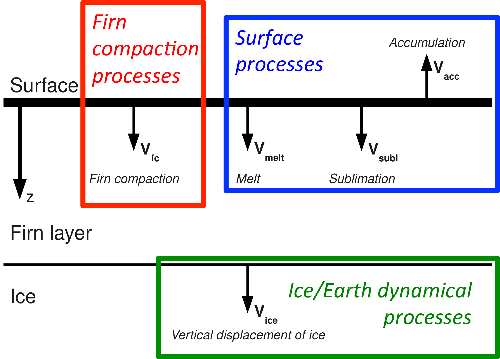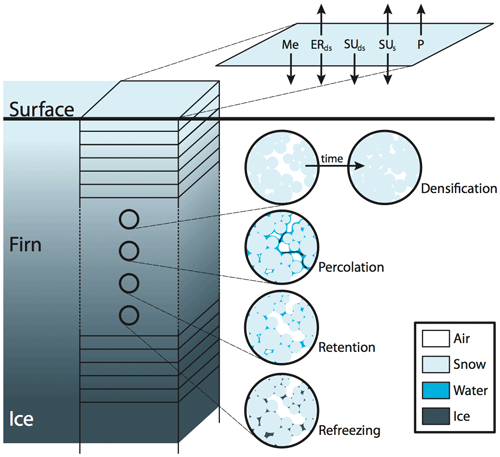Introduction

TEXT NEED TO BE UPDATED
The steady and transient states of the firn layer provide important information on firn processes such as melt percolation and refreezing, firn air content, and surface elevation changes. All processes resulting in changes in the firn layer can be combined in time-dependent firn densification models. These models calculate temporal changes in firn depth and density, and surface height changes, by forcing them with time series of surface temperature, snowfall, sublimation and melt.
The IMAU firn densification model (FDM) calculates steady-state as well as time-dependent firn density profiles. The advantage of this model is that it uses the same densification expression for both purposes, tuned to optimally fit observations. The first model version only incorporated dry snow processes and was used for studies into diffusion of e.g. oxygen isotopes. The current version also includes snowmelt and percolation, and retention and refreezing of meltwater.
Note that the offline firn model described here is identical to the interactive snow model of RACMO2.1 and RACMO2.3 in its physical parameterizations. But by running the firn model offline, the computation time reduces considerably meaning that we are able to create a more realistic initialization of the firn layer (see below) and perform many sensitivity tests at a higher vertical resolution. For firn applications, such as corrections for satellite altimetry, the output of the firn model (forced by RACMO output) is therefore the preferred product.
Model description

Our FDM is a time-dependent one-dimensional model that keeps track of the density and temperature in a vertical firn column. New added surface snow is instantly treated as the upper layer of the vertical firn column. The fresh snow density for each grid point is determined by a parameterization of based on average annual accumulation, 10 m wind speed and surface temperature. In the current model, processes associated with liquid water: rain, snowmelt, percolation and refreezing are implemented by allowing liquid water from rain and/or snowmelt, as prescribed by the forcing data, to exist in – and move through – the firn column. The amount of snowmelt is removed from the top layer, and percolates down into the firn column. It refreezes when it reaches a firn layer with sufficient cold content (T < 0°C) and pore space. To mimic capillary forces, a part of the liquid water remains in a layer that is at 0°C. The maximum amount of pore space used to store liquid water is a function of the snow density. This retained water refreezes when the layer cools. The subsurface heat transport is simulated by using a one-dimensional time-dependent heat-transfer model.
The initial density profile of the time-dependent simulation is obtained by spinning up the model as long as needed to refresh the entire firn layer. As the average annual accumulation and depth of the firn layer vary widely in space, the spin-up period is determined uniquely for every grid point. To obtain the input for the spin-up period, the forcing data period is repeated into a time series long enough to refresh the entire firn layer. Hence, we assume this period is representative for the past 100–1000 years and the firn layer to be in steady state.
Model forcing

In most applications, the FDM is forced at the surface by the surface mass balance, surface temperature and near-surface wind speed from the regional atmospheric climate model RACMO, for which information is provided elsewhere on this website. Model data are usually available every 3 or 6 hrs and on varying horizontal resolutions (5.5 to 55 km). The climate and surface mass balance of RACMO has been favorably evaluated in numerous studies.
